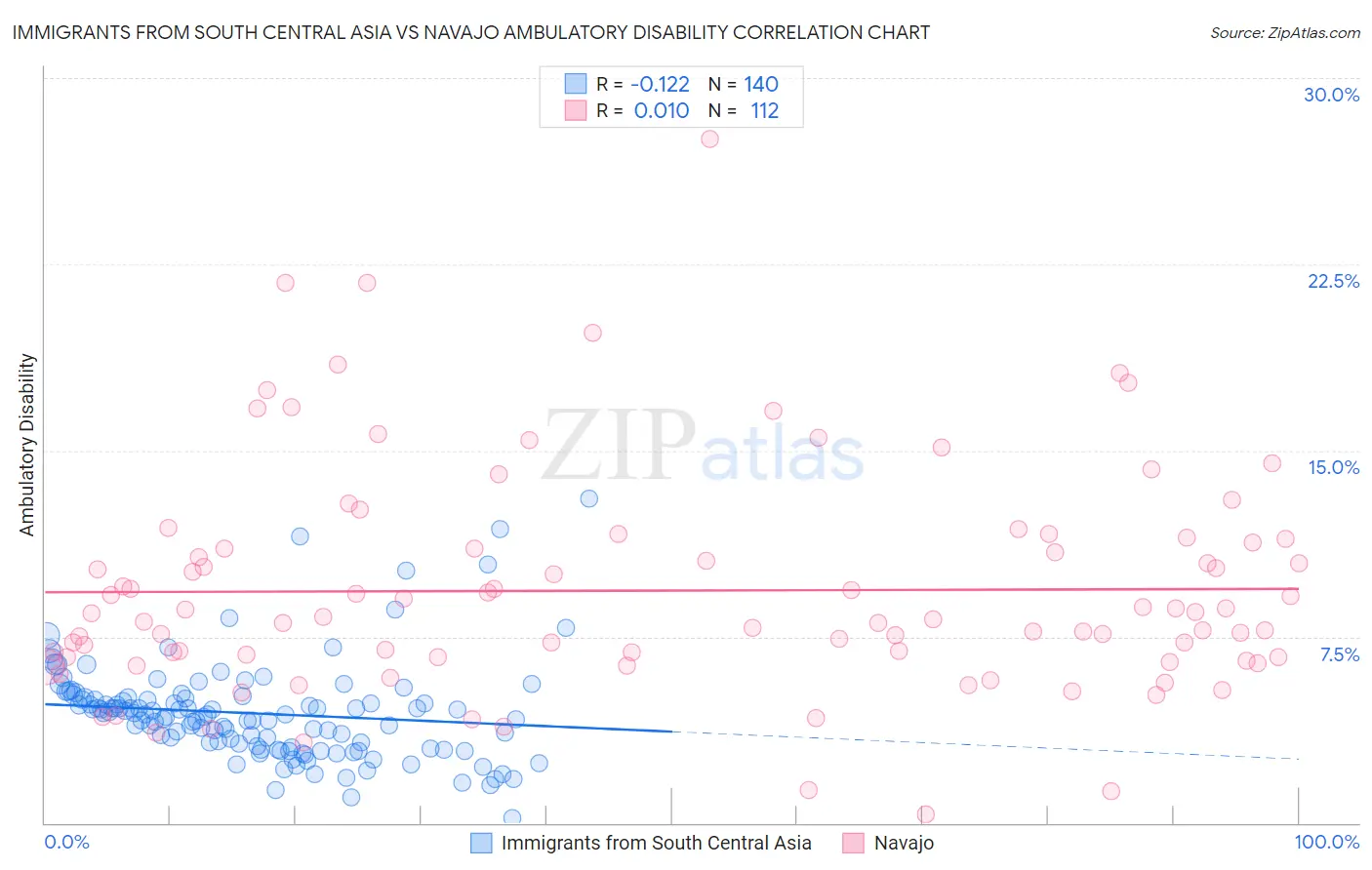Immigrants from South Central Asia vs Navajo Ambulatory Disability
COMPARE
Immigrants from South Central Asia
Navajo
Ambulatory Disability
Ambulatory Disability Comparison
Immigrants from South Central Asia
Navajo
5.1%
AMBULATORY DISABILITY
100.0/ 100
METRIC RATING
8th/ 347
METRIC RANK
7.5%
AMBULATORY DISABILITY
0.0/ 100
METRIC RATING
324th/ 347
METRIC RANK
Immigrants from South Central Asia vs Navajo Ambulatory Disability Correlation Chart
The statistical analysis conducted on geographies consisting of 472,870,749 people shows a poor negative correlation between the proportion of Immigrants from South Central Asia and percentage of population with ambulatory disability in the United States with a correlation coefficient (R) of -0.122 and weighted average of 5.1%. Similarly, the statistical analysis conducted on geographies consisting of 224,747,889 people shows no correlation between the proportion of Navajo and percentage of population with ambulatory disability in the United States with a correlation coefficient (R) of 0.010 and weighted average of 7.5%, a difference of 47.0%.

Ambulatory Disability Correlation Summary
| Measurement | Immigrants from South Central Asia | Navajo |
| Minimum | 0.18% | 0.36% |
| Maximum | 13.0% | 27.6% |
| Range | 12.9% | 27.2% |
| Mean | 4.4% | 9.4% |
| Median | 4.4% | 8.3% |
| Interquartile 25% (IQ1) | 3.0% | 6.7% |
| Interquartile 75% (IQ3) | 5.0% | 11.2% |
| Interquartile Range (IQR) | 2.0% | 4.5% |
| Standard Deviation (Sample) | 2.0% | 4.5% |
| Standard Deviation (Population) | 2.0% | 4.5% |
Similar Demographics by Ambulatory Disability
Demographics Similar to Immigrants from South Central Asia by Ambulatory Disability
In terms of ambulatory disability, the demographic groups most similar to Immigrants from South Central Asia are Iranian (5.1%, a difference of 0.36%), Yup'ik (5.2%, a difference of 0.97%), Bolivian (5.1%, a difference of 0.99%), Immigrants from Bolivia (5.0%, a difference of 1.4%), and Immigrants from Singapore (5.0%, a difference of 2.1%).
| Demographics | Rating | Rank | Ambulatory Disability |
| Immigrants | India | 100.0 /100 | #1 | Exceptional 4.8% |
| Filipinos | 100.0 /100 | #2 | Exceptional 4.9% |
| Thais | 100.0 /100 | #3 | Exceptional 4.9% |
| Immigrants | Taiwan | 100.0 /100 | #4 | Exceptional 4.9% |
| Immigrants | Singapore | 100.0 /100 | #5 | Exceptional 5.0% |
| Immigrants | Bolivia | 100.0 /100 | #6 | Exceptional 5.0% |
| Bolivians | 100.0 /100 | #7 | Exceptional 5.1% |
| Immigrants | South Central Asia | 100.0 /100 | #8 | Exceptional 5.1% |
| Iranians | 100.0 /100 | #9 | Exceptional 5.1% |
| Yup'ik | 100.0 /100 | #10 | Exceptional 5.2% |
| Immigrants | Korea | 100.0 /100 | #11 | Exceptional 5.2% |
| Okinawans | 100.0 /100 | #12 | Exceptional 5.3% |
| Burmese | 100.0 /100 | #13 | Exceptional 5.3% |
| Immigrants | Eastern Asia | 100.0 /100 | #14 | Exceptional 5.3% |
| Immigrants | China | 100.0 /100 | #15 | Exceptional 5.3% |
Demographics Similar to Navajo by Ambulatory Disability
In terms of ambulatory disability, the demographic groups most similar to Navajo are Comanche (7.5%, a difference of 0.070%), Black/African American (7.5%, a difference of 0.18%), Native/Alaskan (7.5%, a difference of 0.20%), Hopi (7.6%, a difference of 1.1%), and Pueblo (7.6%, a difference of 1.2%).
| Demographics | Rating | Rank | Ambulatory Disability |
| Central American Indians | 0.0 /100 | #317 | Tragic 7.2% |
| Ottawa | 0.0 /100 | #318 | Tragic 7.2% |
| Dominicans | 0.0 /100 | #319 | Tragic 7.2% |
| Potawatomi | 0.0 /100 | #320 | Tragic 7.3% |
| Apache | 0.0 /100 | #321 | Tragic 7.4% |
| Osage | 0.0 /100 | #322 | Tragic 7.4% |
| Americans | 0.0 /100 | #323 | Tragic 7.4% |
| Navajo | 0.0 /100 | #324 | Tragic 7.5% |
| Comanche | 0.0 /100 | #325 | Tragic 7.5% |
| Blacks/African Americans | 0.0 /100 | #326 | Tragic 7.5% |
| Natives/Alaskans | 0.0 /100 | #327 | Tragic 7.5% |
| Hopi | 0.0 /100 | #328 | Tragic 7.6% |
| Pueblo | 0.0 /100 | #329 | Tragic 7.6% |
| Paiute | 0.0 /100 | #330 | Tragic 7.7% |
| Cajuns | 0.0 /100 | #331 | Tragic 7.8% |